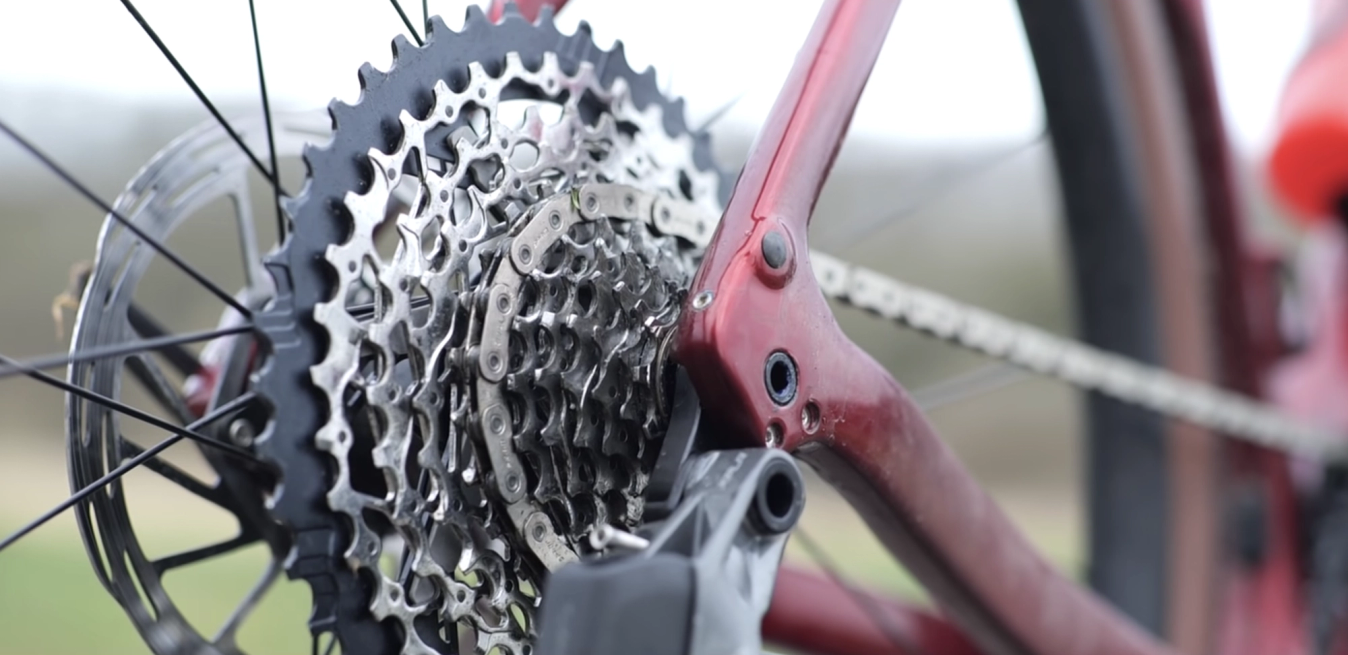The differences between a cyclo-cross bike and a gravel bike
They may look similar, but there are some key differences to consider.
James Howell-Jones
Junior Writer
Cyclo-cross and gravel bikes both look like road bikes. They both have knobbly tyres. They both have 1x drivetrains (mostly). They both have drop bars. They’re both for riding off-road. So they’re basically the same, right?
Well, no. These bikes might look similar on the surface, but in fact, there are some crucial differences between the two. They’re both beefed up road bikes, but they’re designed to tackle different terrains, at different speeds, and for different amounts of time. All told, that makes a bigger impact on how these bikes are designed and built than you might expect.
What each bike is used for
Cyclo-cross bikes

© GCN
Trek Boone 6: a cyclo-cross race machine
First of all you’ve got cyclo-cross bikes. These are thoroughbred race machines. They’re designed for the specific demands of cyclo-cross races – short, off-road races with obstacles like stairs and planks, tight bends and lots of mud or mud.
In a cyclo-cross race, riders have to carry their bikes over the trickiest parts of the course. And with the races lasting only an hour or so, no one carries a water bottle and no one cares about being especially comfortable on the bike. The speeds that riders hit in a cyclo-cross race are limited: there are no long descents or fast straights, and if a climb is too steep to ride up quickly, riders will just get off and run.
Gravel bikes

© GCN
Trek Checkpoint SL 5: gravel grinder and all rounder
On the other hand, there are gravel bikes. These are designed for a totally different style of riding. Gravel bikes are intended for long days on rough terrain. They’re designed to stand up to kilometre after kilometre of battering on rough roads. And they’re made to make those long rides on rough surfaces comfortable and efficient.
Gravel riders want all day comfort, and self-sufficiency. That means they need to be able to attach everything they need to their bike, whether they’re heading out for a day’s ride, or a week’s bikepacking trip.
How both are designed and equipped
Ok, so we know what each bike is intended to do, but how does that change how they’re designed and built?
Geometry
One of the biggest differences between cyclo-cross bikes and gravel bikes is the geometry. Geometry is determined by the frame of the bike, and it collectively describes things like the head angle (the angle the forks are at), the seat angle (the angle of the seat tube and seatpost), the wheelbase, stack height, bottom bracket drop and more. Differences in geometry are subtle, but they make a big difference to the feel of a bike.
Cyclo-cross bikes have a geometry that makes them ideal for slow, twisty courses. They have a short wheelbase and a steep head angle and seat angles. Combined, these features make cyclo-cross bikes agile and unstable, perfect for tight corners and quick manoeuvres. At speed, these bikes would be a handful, but on a cyclo-cross course they’re fantastic.
The geometry of gravel bikes is completely different. The goal is to make them stable and sure-footed. To achieve this, they’re given relaxed geometry, with a slack head angle and seat angle, a longer wheelbase and a lower bottom bracket. All these features mean gravel bikes are slower to turn, but far easier to keep pointing in a straight line, even if the ground is rocky and rutted.
Practicality

© GCN
Fork mounts are great for bags, bottles or racks
On a gravel bike, practicality is key. These bikes are touted as 'do-it-all' generalists, so they come bristling with mounting points for pannier racks, mudguards, water bottles and more.
Gravel bikes are designed for long rides over rough surfaces, so comfort is key. To smoothen out the ride, they often have vibration dampening technology. Sometimes, this is as simple as some compliancy built into the frame or seatpost. But increasingly, gravel bikes are using shock absorbers, elastomers and even suspension.
Practicality simply isn’t on the agenda for cyclo-cross bikes. In fact, some don’t even have two water bottle mounts. Designers don’t need to think about how the bikes would be useful in the real world. Instead, they focus on making cyclo-cross bikes better for racing.
A key part of cyclo-cross racing is that bikes are slung over riders’ shoulders to run up stairs or jump tricky obstacles. To make this as easy and as comfortable as possible, bike brands make the frame shape as ergonomic as possible to carry, by moving cables out of the way and raising the top tube.
On the twisty turns of a cyclo-cross course, pedal strike is a real issue. To stop riders’ inside pedal from hitting the ground while cornering or riding in ruts, cyclo-cross bikes are given high bottom brackets, which subsequently raises the pedals up higher. This means riders can pedal through corners, but it makes the bikes even more unstable and agile.
Gears

© GCN
Close-range cassette on the Trek Boone
On a cyclo-cross course, the range of speed is pretty small. There’s no epic climbs or long, fast straights. And because the races are short, riders don’t really pace themselves or ride slowly: it’s pretty much full gas from the gun. If the hill is too steep to ride quickly, everyone gets off, chucks their bike over their shoulder, and runs. For this kind of riding, you really don’t need a huge spread of gears.

© GCN
Like most gravel bikes, Trek's Checkpoint features a wide-range cassette
On a gravel bike, the opposite is true. These bikes are designed to tackle a huge variety of terrains, from steep, technical climbs to cruisy road sections. As a result, the gear range on gravel bikes is far bigger. This larger range is really handy for riding with bags. Riding with camping gear adds a lot of weight and slows riders down, so they need extra easy gears to spin up climbs with.
Tyres
For both gravel bikes and cyclo-cross bikes, there are loads of tyres to choose from. Each type of tyre is intended for different conditions, with some for dry ground, some for mud, some even for snow and ice.

© GCN
Cyclocross bikes are designed around 32mm tyres
While both bikes have a huge range of tyre choice, the main difference between the two is in the width. Professional cyclo-cross is governed by the UCI, who set a 33mm limit for tyre width. As a result, pretty much everyone rides 33mm cyclo-cross tyres, as wide as you can get while still being race-legal. And because cyclo-cross courses are, as a rule, wet and muddy, most cyclo-cross tyres are designed to cut through the sloppy stuff and find the grip underneath.

© GCN
Gravel bikes allow for far wider tyres, often up to 50mm
The range of gravel tyres is so broad that it’s impossible to generalise. At one end of the spectrum, gravel tyres are beefed up road bike tyres, with slightly more developed tread patterns. At the other, they are indistinguishable from mountain bike tyres, with chunky tread and thick casings. The one thing we can say about gravel tyres, is that almost all of them are wider than 33mm. 33mm is considered skinny in the gravel world, with most riders using something between 35 and 50mm tyres.
To accommodate these bigger tyres, gravel bikes often have far more clearance around the wheels. It’s another design feature that makes gravel bikes that bit more practical and versatile than their cyclo-cross cousins.
Can I ride cyclo-cross on a gravel bike and gravel on a cyclo-cross bike?
Despite all of the above, both bikes work pretty well on each other’s turf. If you enter a cyclo-cross race on your gravel bike, it’ll be absolutely fine, and if you ride gravel on your cyclo-cross bike, the bike won’t disintegrate underneath you. Both bikes are capable of doing both types of riding.
That doesn’t mean that there’s no difference between the two bikes, or that the difference is inconsequential. In fact, really it just shows that both bikes are incredibly capable on a range of terrains. Ultimately, you should still think carefully about which is better for the riding you’re going to do. They each have a specialism, so choose the bike that makes sense for the riding you do most of the time.
Horses for courses
While these two types of bike look pretty similar, there’s more that sets them apart than first meets the eye. Cyclo-cross bikes are race-specific, with narrow gear ranges, narrow tyres, and race-oriented features. Gravel bikes, on the other hand, are designed for a wide range of conditions, and a number of different purposes.
For most of us, the gravel bike makes far more sense – you can ride them pretty much anywhere, load them up with bags, and even do a cyclo-cross race or two. If you’re a serious cyclo-cross racer, however, or even if you simply like the feel of an agile, unstable bike, a cyclo-cross might be the right choice for you.











.jpg?w=600&auto=format)